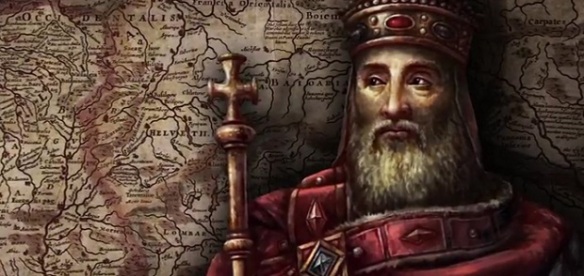Born: April 2, 742
Died: January 28, 814
Frankish King and Emperor
Charles the Great was the son of Pepin, the first king of the Carolingian empire. Pepin’s domains at his peak of power covered most of present-day France, in addition to Belgium and areas of Germany. The single ruler of this particular extensive kingdom from 771, Charlemagne was above all a war leader, expected to take his army on campaign every year. He is reckoned to have undertaken 30 campaigns in person in the course of his sovereignty – to maintain his authority, expand his domains, and forcibly spread the Christian faith.
Charlemagne had no standing army and no bureaucracy, however he achieved a high degree of organization and the assembly and supply of his forces. His chief nobles, the counts, were responsible for raising the various soldiers which he needed, with equipment for each and every man. The warriors brought some food with them, while extra supplies were requisitioned from landowners. The Army typically assembled in the spring season and summer and fought in the autumn. Charlemagne continuously gathered intelligence on the domain in which he intended to fight and normally prepared careful plans. He usually divided his forces in two or more columns when advancing into hostile territory, presumably mainly because a smaller sized body of men would find it easier to contend with the difficulties of movement and supply. Charlemagne’s horse cavalry were his essential troops. Retainers of the Frankish nobles, the armored horsemen were obliged to show up prepared for military service when required by the king. Armed with a lance, sword, as well as shield, they fought mounted, relying on stirrups and high-back saddle to maintain a stable seat in combat. Pitched battles were unusual, campaigns commonly comprised of skirmishes, assaults on bastioned settlements, resisting or avoiding ambushes, and much laying to waste towns and countryside. Although in the first quarter century of his sovereignty Charlemagne commanded his army in person, he was not a ruler renowned for prowess in face-to-face combat. His real qualities lay in his authority, organization, willpower, and ruthless persistence.
Charlemagne fought several wars in opposition to typically inferior resistance around his extensive borders, but even so success was certainly not assured. He faced challenging opposition from insurgents and his resources were overstretched against a variety of opponents. The campaign in which Charlemagne trampled over the Lombard kingdom of North Italy in 773 – 74 exemplified unhesitating military action. After marching across Alpine passes in columns, the Franks who emerged on the north Italian plane were too numerous for the enemy to take on. Charlemagne came to a halt at the Lombard capital, Pavia, and laid siege to the city until it capitulated. Even though further campaigns in Italy against Lombards and Byzantines were needed, a political arrangement he imposed held firm, establishing Frankish control of the northern half of Italy. Campaigning in Iberia turned out to be more challenging. Virtually all of Spain was subjected to Muslim rule, and divisions between the Arabs and the few small Christian states that did exist gave Charlemagne an opportunity to step in. But the resulting journey in northern Spain in 778 was one of the most unfortunate disasters of his career.
At the end of an unsuccessful foray to Zaragoza, he was leading his military straight back across the Pyrenees in the rearguard when his forces were ambushed and massacred. The death of prominent Frankish nobles in this attack provided material for a well-known medieval epic: The Song of Roland. It was considered embarrassing to have fallen into this sort of trap. Later in his reign, the Franks with success occupied a protective buffer zone south of the Pyrenees, including Barcelona. Most of Charlemagne’s wars were aimed across the open eastern frontier of his domains, most importantly against Saxons. These independent, pagan groups were repeatedly terrorized by Charlemagne’s columns, who were always ready to rebel again when the Franks were distracted. The resistance angered Charlemagne, who is guilty of an appalling massacre of 4,500 Saxons at Verden in 782. The submission of the inspired guerrilla leader Widukind in 785 did not end the opposition, but that marked the point at which it could no longer succeed.
By the 790s Charlemagne had begun to delegate military operations to his sons or to nobles. He was not personally involved in demolishing the nomads who dominated the Danube Valley, but he did plan to construct a canal linking the Rhine and Danube to facilitate the movement of his troops – an engineering undertaking that proved to be well outside the Frank’s engineering capabilities. By 800, when Charlemagne was crowned Emperor by the Pope, the age of yearly campaigns was coming to a close, as was his individual command of army operations. It established his kingdom into an empire stretching as far south of central Italy and Barcelona and as far east as the Elbe. To ensure the succession to his throne, Charlemagne crowned his son Louis the Pious as co-Emperor. When Charlemagne died the following year in 813, Louis succeeded him.
